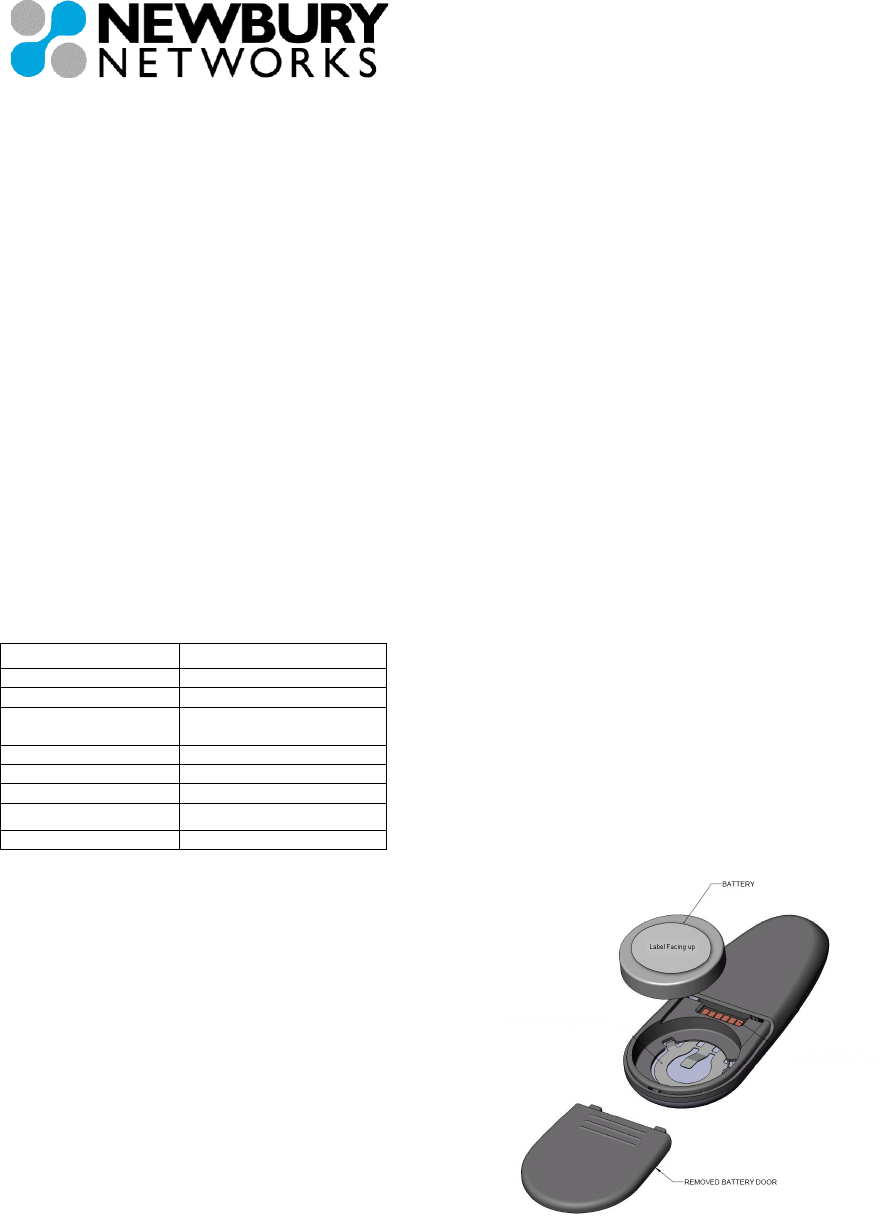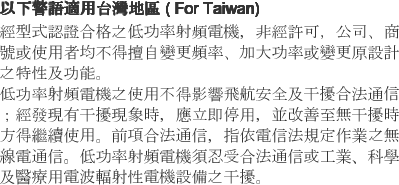Juniper Networks 330 AT-330 Asset Tag User Manual AT 330 Users Guide
Juniper Networks, Inc. AT-330 Asset Tag AT 330 Users Guide
User Manual

Part Number: 730-9502-0308 Rev A © 2010 All rights reserved.
AT-330 Asset Tag
Introduction
The Newbury AT-330 asset tag, is a battery powered,
802.11b/g, Wi-Fi compatible, sensor platform that is
capable of being networked in a WLAN environment.
The AT-330 can receive and send Wi-Fi compatible
messages at user defined intervals. The Wi-Fi sensor
platform serves as a means to become an active RFID
tag where the RFID platform can send messages with
unique ID’s and/or data encoded from several sensors
which are part of the tag. The AT-330 seamlessly
becomes part of the users wireless network
infrastructure in that the tag becomes just another user
on the WLAN network. The AT-330 and its inherent
sensors can be configured to the application best suited
by the user.
Product Specification
The following table summarizes the allowed
performance characteristics of the Newbury AT-330
asset tag:
Parameter Description
Frequency Band 2.412 to 2.462 GHz
Connectivity Protocol DSSS 802.11 b/g
Modulation CCK, BPSK, QPSK,
OFDM
Transmit Power 18 dBm
Input Power 3.6 V Lithium Battery
Message Length Variable
Transmission Interval Variable
Duty Cycle 25% Maximum
Hardware Description
Integrated WiFi Module:
• Low power 802.11 b/g system module with
support for WEP/WPA/WPA2 encryption
Integrated Sensors:
• Onboard Temperature Sensor
• Motion Detection
• Magnetic Detachment Detection
Input/Output:
• 2 LEDs
• 2 Push-button switches
Power:
• 1000mAh Thionyl Chloride Lithium Battery
• 6 month to 2 year battery life (depending upon
configuration)
Operating Conditions
AT-330 Operating conditions specifications:
Temperature:
• Operating temperatures: -20C to +70C
• Storage temperatures: -40C to +70C
Humidity:
• Operating: 10% to 95% non-condensing
Power:
• Input voltage range: 2.7v to 3.7v
• Maximum continuous current: 10mA
• Rated 1 Sec Pulse: 20mA
Additional Documentation
For more details on how to use the AT-330 Asset Tag
with Newbury Active Asset, refer to the Newbury Active
Asset User’s Guide.
Notice To User: Newbury AT-330 asset tag is to be
configured by Professional Installers only who have
received training on the proper configuration that
can and will affect the tags operation and
performance.
Contacting Newbury Networks
For most current issue of this document, complete
regulatory guide and more information on Newbury's
products and services, please contact your local
Newbury certified channel partner or a Newbury
Networks representative at 617-867-7007 or via email at
info@newburynetworks.com.
Battery Installation
The AT-330 battery included with the AT-330 asset tag
must be installed prior to tag operation. Remove the rear
battery door using the raised thumb grips on the battery
door, and place the included battery (label facing up)
inside the battery compartment. Close the battery door,
by pressing down and forward with the thumb grips. See
the illustration below:

Product Safety
CSA 60950-1, 2nd Ed.
UL 60950-1, 2nd Ed.
IEC 60950-1: 2005 (2nd Edition)
EN 60950-1: 2006 (2nd Edition)+ A11 (2009)
Federal Communications Commission Interference
Statement
This equipment has been tested and found to comply
with the limits for a Class B digital device, pursuant to
Part 15 of the FCC Rules. These limits are designed to
provide reasonable protection against harmful
interference in a residential installation. This equipment
generates, uses and can radiate radio frequency energy
and, if not installed and used in accordance with the
instructions, may cause harmful interference to radio
communications. However, there is no guarantee that
interference will not occur in a particular installation. If
this equipment does cause harmful interference to radio
or television reception, which can be determined by
turning the equipment off and on, the user is encouraged
to try to correct the interference by one of the following
measures:
1. Reorient or relocate the receiving antenna.
2. Increase the separation between the
equipment and receiver.
3. Connect the equipment into an outlet on a
circuit different from that to which the receiver
is connected.
4. Consult the dealer or an experienced radio/TV
technician for help.
This device complies with Part 15 of the FCC Rules.
Operation is subject to the following two conditions: (1)
This device may not cause harmful interference, and (2)
this device must accept any interference received,
including interference that may cause undesired
operation.
FCC Caution: Any changes or modifications not
expressly approved by the party responsible for
compliance could void the user's authority to operate this
equipment.
Operating this product in the U.S.A. is firmware-limited to
channels 1 through 11.
IMPORTANT NOTE:
FCC Radiation Exposure Statement:
This equipment complies with FCC radiation exposure
limits set forth for an uncontrolled environment. End
users must follow the specific operating instructions for
satisfying RF exposure compliance. To maintain
compliance with FCC RF exposure compliance
requirements, please follow operation instruction as
documented in this manual.
This transmitter must not be co-located or operating in
conjunction with any other antenna or transmitter.
Industry Canada Statement
This device complies with RSS-210 of the Industry
Canada Rules. Operation is subject to the following two
conditions:
1) this device may not cause interference and
2) this device must accept any interference, including
interference that may cause undesired operation of the
device
IMPORTANT NOTE:
IC Radiation Exposure Statement:
This equipment complies with IC radiation exposure
limits set forth for an uncontrolled environment. End
users must follow the specific operating instructions for
satisfying RF exposure compliance. To maintain
compliance with IC RF exposure compliance
requirements, please follow operation instruction as
documented in this manual.
CE Mark Compliance:
European Council Directives 1999/5EC (R&TTE),
2004/108/EC (EMC),
2006/95EC (LVD)
Environmental Directives 2002/95/EC, 2006/122/EC and
2006/66/EC
CAUTION
RISK OF EXPLOSION IF BATTERY IS REPLACED BY
AN INCORRECT TYPE. DISPOSE OF USED
BATTERIES ACCORDING TO THE FOLLOWING
INSTRUCTIONS
Battery Disposal Instructions: Different to the policy of
each country. Normally, it is not allowed to throw away.
- Proper Shipping Name: Used Lithium Batteries
- UN Number: UN3090
- Hazard Classification: Class 9(Miscellaneous)
- Packing Group : II
- Labels Required: Miscellaneous Hazardous
Waste
- Disposal Code: D003
- Other: All lithium thionyl chloride batteries should
be disposed of by a proper disposal facility